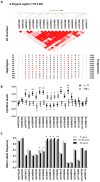Selection for genetic variation inducing pro-inflammatory responses under adverse environmental conditions in a Ghanaian population
- PMID: 19907653
- PMCID: PMC2771352
- DOI: 10.1371/journal.pone.0007795
Selection for genetic variation inducing pro-inflammatory responses under adverse environmental conditions in a Ghanaian population
Abstract
Background: Chronic inflammation is involved in the pathogenesis of chronic age-associated, degenerative diseases. Pro-inflammatory host responses that are deleterious later in life may originate from evolutionary selection for genetic variation mediating resistance to infectious diseases under adverse environmental conditions.
Methodology/principal findings: In the Upper-East region of Ghana where infection has remained the leading cause of death, we studied the effect on survival of genetic variations at the IL10 gene locus that have been associated with chronic diseases. Here we show that an IL10 haplotype that associated with a pro-inflammatory innate immune response, characterised by low IL-10 (p = 0.028) and high TNF-alpha levels (p = 1.39 x 10(-3)), was enriched among Ghanaian elders (p = 2.46 x 10(-6)). Furthermore, in an environment where the source of drinking water (wells/rivers vs. boreholes) influences mortality risks (HR 1.28, 95% CI [1.09-1.50]), we observed that carriers of the pro-inflammatory haplotype have a survival advantage when drinking from wells/rivers but a disadvantage when drinking from boreholes (p(interaction) = 0.013). Resequencing the IL10 gene region did not uncover any additional common variants in the pro-inflammatory haplotype to those SNPs that were initially genotyped.
Conclusions/significance: Altogether, these data lend strong arguments for the selection of pro-inflammatory host responses to overcome fatal infection and promote survival in adverse environments.
Conflict of interest statement
Figures



Similar articles
-
The influence of genetic variation on innate immune activation in an environment with high infectious pressure.Genes Immun. 2012 Feb;13(2):103-8. doi: 10.1038/gene.2011.57. Epub 2011 Aug 11. Genes Immun. 2012. PMID: 21833021
-
Promoter polymorphisms in IL-6 gene influence pro-inflammatory cytokines for the risk of osteoarthritis.Cytokine. 2020 Mar;127:154985. doi: 10.1016/j.cyto.2020.154985. Epub 2020 Jan 14. Cytokine. 2020. PMID: 31951965
-
Common CFTR gene variants influence body composition and survival in rural Ghana.Hum Genet. 2010 Feb;127(2):201-6. doi: 10.1007/s00439-009-0762-2. Epub 2009 Nov 5. Hum Genet. 2010. PMID: 19890664 Free PMC article.
-
IL10 haplotype associated with tuberculin skin test response but not with pulmonary TB.PLoS One. 2009;4(5):e5420. doi: 10.1371/journal.pone.0005420. Epub 2009 May 1. PLoS One. 2009. PMID: 19412539 Free PMC article.
-
Interleukin-10 promoter gene polymorphisms are associated with the first major depressive episode in chronic hepatitis C patients.Clin Res Hepatol Gastroenterol. 2019 Aug;43(4):417-426. doi: 10.1016/j.clinre.2018.11.015. Epub 2018 Dec 24. Clin Res Hepatol Gastroenterol. 2019. PMID: 30591371
Cited by
-
Neuroinflammation and neuroprogression in depression: Effects of alternative drug treatments.Brain Behav Immun Health. 2022 Nov 8;26:100554. doi: 10.1016/j.bbih.2022.100554. eCollection 2022 Dec. Brain Behav Immun Health. 2022. PMID: 36388140 Free PMC article. Review.
-
Immune age and biological age as determinants of vaccine responsiveness among elderly populations: the Human Immunomics Initiative research program.Eur J Epidemiol. 2021 Jul;36(7):753-762. doi: 10.1007/s10654-021-00767-z. Epub 2021 Jun 12. Eur J Epidemiol. 2021. PMID: 34117979 Free PMC article.
-
Côte d'Ivoire Dual Burden of Disease (CoDuBu): Study Protocol to Investigate the Co-occurrence of Chronic Infections and Noncommunicable Diseases in Rural Settings of Epidemiological Transition.JMIR Res Protoc. 2017 Oct 27;6(10):e210. doi: 10.2196/resprot.8599. JMIR Res Protoc. 2017. PMID: 29079553 Free PMC article.
-
Effect of APOE ε4 allele on survival and fertility in an adverse environment.PLoS One. 2017 Jul 6;12(7):e0179497. doi: 10.1371/journal.pone.0179497. eCollection 2017. PLoS One. 2017. PMID: 28683096 Free PMC article.
-
Cardiovascular disease and type 2 diabetes in evolutionary perspective: a critical role for helminths?Evol Med Public Health. 2016 Jan;2016(1):338-357. doi: 10.1093/emph/eow028. Epub 2016 Sep 25. Evol Med Public Health. 2016. PMID: 27666719 Free PMC article. Review.
References
-
- Cooke GS, Hill AV. Genetics of susceptibility to human infectious disease. Nat Rev Genet. 2001;2:967–977. - PubMed
-
- Le Souef PN, Goldblatt J, Lynch NR. Evolutionary adaptation of inflammatory immune responses in human beings. Lancet. 2000;356:242–244. - PubMed
-
- van Bodegom D, May L, Meij HJ, Westendorp RG. Regulation of human life histories: the role of the inflammatory host response. Ann N Y Acad Sci. 2007;1100:84–97. - PubMed
-
- Crawley E, Kay R, Sillibourne J, Patel P, Hutchinson I, et al. Polymorphic haplotypes of the interleukin-10 5′ flanking region determine variable interleukin-10 transcription and are associated with particular phenotypes of juvenile rheumatoid arthritis. Arthritis Rheum. 1999;42:1101–1108. - PubMed
Publication types
MeSH terms
Substances
Associated data
- Actions
LinkOut - more resources
Full Text Sources

